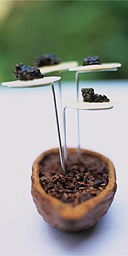
What are Michelin stars?
They are the best known and most highly respected of all restaurant ratings, not just here, but in France where they originated and in many of the 22 countries the guides now cover.
One star signifies a very good restaurant
Two stars signify excellent cooking that is worth a detour
Three stars signify exceptional cuisine that is worth a special journey
The Rising Star distinction, introduced in 2006, highlights the best restaurants in each category, which may move up to the next level soon.
How many starred restaurants are there in Britain?
There have been a record 122 starred eateries in Great Britain and Ireland for two years running. Of these, the vast majority have one star (107), 12 have two stars and just three garner top marks (the Fat Duck, the Waterside Inn and Gordon Ramsay).
Why are Michelin stars so important?
Restaurant-goers place more trust in them as a mark of quality than any other award or rating. For chefs, Michelin stars are the ultimate accolade.
Is there a downside?
Michelin does come in for criticism. The main bones of contention are:
Slow reactions: Andy Hayler, who has eaten his way around the world's three-star restaurants, says that Michelin "is very slow to react to change at a restaurant, so it is tardy both to give stars and to take them away."
Poor standards: A former inspector, Pascal Rémy, said that although all restaurants are supposed to be revisited every 18 months, they are actually only visited every three-and-a-half years, unless a specific complaint had been made. Rivals Hardens pointed out that the 2008 guide includes an entry for a London restaurant called Ribbands that actually closed in summer 2007.
Pressure on chefs: The Observer's restaurant critic, Jay Rayner, said "there is nothing worse than a young chef desperately cooking for stars rather than his customers." And Matthew Norman, the Guardian's restaurant critic, said Michelin demands "a level of pretentiousness that is normally nauseating."
French bias: There have been many accusations that the rating system is biased towards French cuisine, and France itself is certainly more thoroughly covered by Michelin than any other country.
Lack of transparency: However controversial its decisions, Michelin never says publicly why a particular restaurant did or did not receive a star. But, as Jay Rayner points out, this secrecy is "part of what makes Michelin so interesting (and infuriating)."
What are the criteria for awarding stars?
According to Michelin, stars reflect "what's on the plate and only what's on the plate". The five criteria they are judged on are:
· The quality of ingredients
· The skill in their preparation and the combination of flavours
· The level of creativity
· The value for money
· The consistency of culinary standards
Other criteria, such as décor and service, are indicated by fork-and-spoon symbols, and do not affect star ratings.
Who are the inspectors and what do they do?
There are 80 full-time Michelin inspectors. The average age of an inspector is 40, and they tend to be hotel school graduates with at least five years' experience in the restaurant or hotel industry. New recruits receive six months' training and work with an experienced inspector before going it alone.
Every year, each inspector evaluates 240 restaurants, spends 130 nights in hotels, carries out 800 inspections, writes 1,100 reports and drives 18,000 miles. A typical day starts at 7am and ends at 11pm. Inspectors eat at restaurants anonymously and pay the bill, though afterwards they may introduce themselves and ask for more information. If there is any doubt about a restaurant, another inspector will go to eat there for a second opinion.
The inspectors, the editor of the Michelin guide and the director of Michelin all meet several times a year. They discuss the restaurants and compare reports, and decide whether to award stars.
Can ordinary restaurant-goers influence ratings?
Allegedly. Readers can make comments and suggestions about restaurants, which may lead to a visit by an inspector. Forty-five thousand letters and emails are received and replied to each year, and Michelin claims these views are taken into account.
Aren't all starred restaurants really expensive?
Not necessarily. While one of the criteria for stars is the quality of the ingredients, this doesn't mean the ingredients have to be luxurious - but they do have to be very fresh. However, in reality starred restaurants do tend to be expensive, which Michelin tacitly acknowledged in 1995 by introducing the Bib Gourmand. This is a separate category for restaurants that serve great food at reasonable prices (three courses for less than £28). In fact, starred restaurant only make up 10% of all restaurants included in the guide.
Can pub get stars?
Yes. The Stagg Inn in Titley was the first pub to be awarded a star in 2001. There have since been more one-star pubs - this year, the Sportsman in Kent received the accolade.
What's the history of Michelin in Britain?
The first ever Michelin Guide to the British Isles was published in 1911. In 1974, when the guide was relaunched in its modern guise, 25 restaurants managed one star. In 1977, four restaurants were awarded two stars for the first time (the Connaught, Le Gavroche, the Waterside Inn and the Box Tree). In 1982, Britain could finally boast a three-star restaurant thanks to Monsieur Roux at Le Gavroche.

